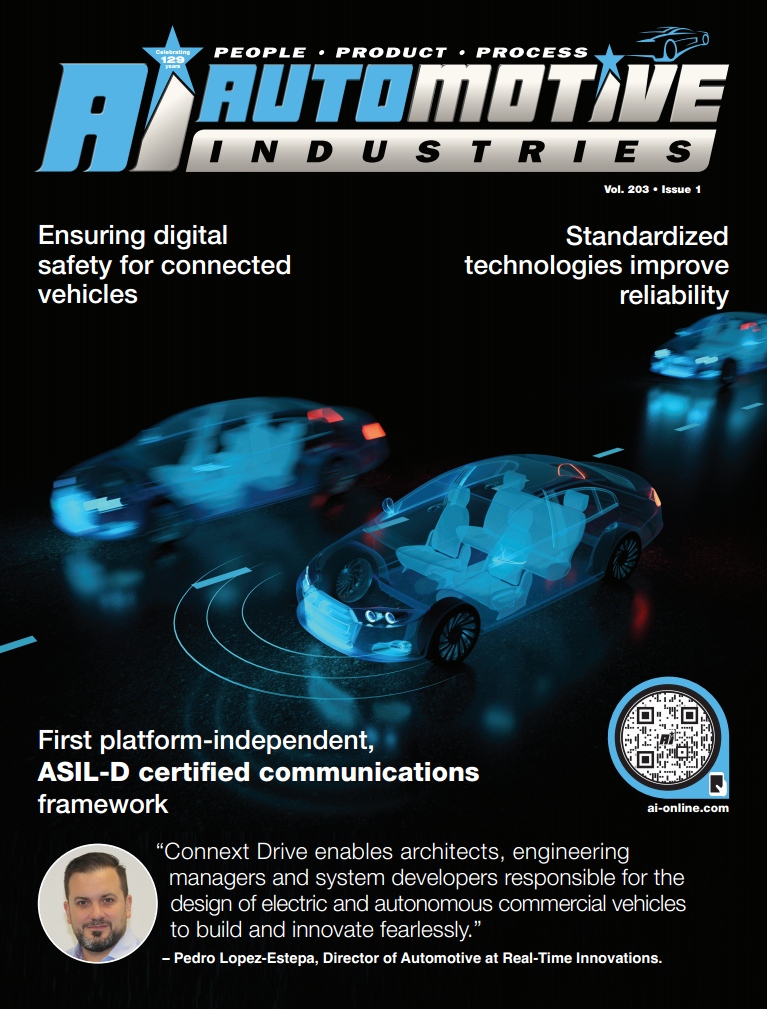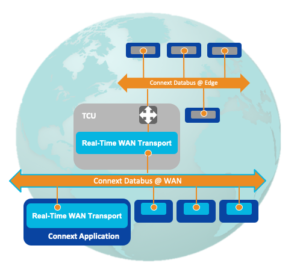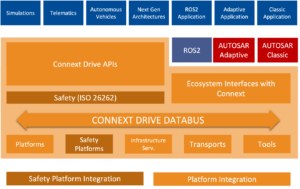
Software is taking over and disrupting the automotive market, but the journey has been bumpier than some might have expected.
Software-defined vehicle (SDV) architectures are the initial step towards autonomous mobility, but this evolution brings its own set of risks and challenges.
Automotive Industries (AI) asked Pedro Lopez-Estepa, Director of Automotive at Real-Time Innovations (RTI), what the main concerns are for companies in the autonomous and software-defined vehicle sectors
Lopez-Estepa: Each challenge on its own is largely uncharted territory for OEMs.

Together, they present designers with a myriad of matrixed challenges.
The stakes for success are incredibly high, from the confidence of consumers and regulators to market innovation and even survival.
The primary challenges the industry is experiencing to advance the integration of SDV architectures are:
- Clarifying the concept of what a software-defined vehicle means is a significant hurdle due to varying interpretations among OEMs
- The challenge primarily revolves around establishing industry-standard hardware interfaces, vehicle APIs and data models
- Enabling collaboration with a strong ecosystem that includes both new suppliers that provide unique capabilities, as well as integrating traditional supply chain vendors, all aimed to mitigate risk
- Ensuring system scalability and future-proofing the vehicle architecture.
AI: What is your solution?
Lopez-Estepa: RTI has launched Connext Drive 3.0, the latest product offering in our automotive line.
It is the first platform-independent, ASIL-D certified communications framework for automotive, and it also has the industry’s first integration toolkits that bridges the gap between AUTOSAR Classic, AUTOSAR Adaptive and DDS.
Connext Drive enables architects, engineering managers and system developers responsible for the design of electric and autonomous commercial vehicles to build and innovate fearlessly.
With this release, Connext Drive is the first DDS-based com

munications framework that adheres to the highest functional safety standards (ISO26262 ASIL D).
OEMs now have a flexible, accelerated path to certification that eliminates the need for recertification if the vehicle operating system or network interfaces change.
AI: Do you see the standardization of technology across manufacturers playing a crucial role in scaling electric and autonomous vehicles?
Lopez-Estepa: The required transformation won’t occur until the industry defines its interfaces, standards and architectures.
The shift towards intelligent, connected, and autonomous vehicles demands a new level of sophistication in the design and integration of automotive software.
As vehicles become more complex and the interoperability of different suppliers needs to cooperate, the need for robust and efficient standard communication mechanisms across heterogeneous systems becomes paramount.
Technologies like the Data Distribution Service (DDS™) standard, AUTOSAR Classic, Adaptive and ROS 2 have emerged as critical enablers for building resilient and scalable automotive systems.
The other reason for industry to promote the use of standard technologies is the level of liability. The implementation of standard-based technologies facilitates supplier choice and eases the risk in the OEM’s eyes.
RTI is the leading provider of DDS and is in the position to ensure interoperability between all these technologies to accelerate time to market, reduce cost and optimize the needs of the industry.
RTI is an active member of AUTOSAR, AVCC®, COVESA, OMG® and SOAFEE, along with other leading automotive technology providers. The main goal of these organizations is to define what the new software-defined vehicle will look like.
AI: What technical path and business model requirements have you identified during RTI’s 20-year involvement with the DDS standard?
Lopez-Estepa: RTI has the largest engineering team in the world dedicated to DDS, with professional services and global support to help drive project success.
This focus provides RTI customers with a communication framework that allows them to manage risk, while increasing the scalability, modularity and reusability of their solutions with the highest levels of safety and cybersecurity.
Starting at the foundation of the DDS standard, RTI has taken the leadership of this technology to help contextualize its unique values to industries: Avionics, Defense, Healthcare and Automotive.

In the case of automotive, there is the need of dedicated software components for key software-defined vehicle (SDV) use cases: ECUs, zonal gateways, high performance compute in ADAS, digital cluster and vehicle control, as well as telematics, cloud implementations and OEM-specific applications.
RTI’s development processes for Connext Drive have been officially certified to ISO 26262 ASIL -D, offering manufacturers an accelerated path to building safety-critical systems for electric and autonomous vehicles.
The automotive industry has unique challenges in terms of business model, given the fact that the development of a given vehicle takes over half a decade and the business is centered around the volumes.
RTI has adapted its business model to align with the needs of the different industry players: OEMs, Tier-1s and Tier-2s, with an emphasis on the integration of safety and cybersecurity components.
Being located in Silicon Valley, RTI has extensive experience in developing mission-critical systems across various industries.
AI: How do the challenges in the electric and autonomous vehicle space compare to those in other sectors such as Healthcare, Energy, Industrial Automation, and Aerospace and Defense?
Lopez-Estepa: While the principle around mission-critical systems might be similar, each industry has a level of differentiation that makes them unique.
RTI has been able to benefit from an extensive mission-critical culture that accelerates the transition towards automotive systems.
Nevertheless, a large level of investment was required to create an automotive solution.
RTI has created a dedicated product line in automotive to satisfy the needs of the industry. This includes dedicated product development processes to comply with automotive specifications as well as a rich set of products that can be effectively contextualized into the different architectural components.
AI: How is RTI supporting the unique communication and data distribution requirements of electric vehicles?
Lopez-Estepa: In automotive, RTI works with over 25 automotive companies which use our technology to accelerate their software-defined vehicle programs.
Today, RTI is in production with 10 vehicle manufacturers around the world who rely on RTI software to design zonal, ADAS and telematics architectures as they evolve in the software-defined era.
DDS, given its unique capabilities, is the best positioned communication framework to dominate the transition towards software-defined era.
The availability of several commercial implementations paired with a superior performance is supporting the exponential growth of DDS in the automotive industry.
AI: Please provide examples of how RTI’s software architecture has facilitated the integration of AI, autonomy, and security in the automotive industry.
Lopez-Estepa: AI, while properly used, is a great tool in optimizing all phases of vehicle software development efforts.
However, it cannot be taken as the sole solution to solving SDV challenges.
The integration of AI functionalities is a progressive and continuously evolving activity that will fully depend on certain architecture standardizations.
For AI to work in the real world, it needs a reliable and fast connection to sensors and motors.
This connection must also be scalable and organized to handle a large number of components.
The challenge is not in the algorithms or processors but in the importance of data.
The key to progress is enabling AI to access and use data effectively in the real world and that is what Connext Drive helps with.
AI: Five of the top 10 public electric vehicle companies and major auto manufacturers are using RTI’s software. How does RTI contribute to their success in the electric and autonomous vehicle markets?
Lopez-Estepa: The key advantages of RTI that have made Connext Drive the leading DDS-based communication framework are:
- Future-proof and Flexible: Connext Drive enables OEMs to embrace change effortlessly. With the new platform-independent architecture and dedicated product footprint for each architectural component, developers can use the same framework from prototype to production.
- Built for Safety: Connext Drive is the first DDS-based, platform-independent communications framework that adheres to the highest functional safety standards (ISO26262 ASIL D).
- Bridges the Platform Gap: Connext Drive supports the co-location of different technologies by operating natively on DDS, or by providing direct integrations within AUTOSAR Classic and AUTOSAR Adaptive and interoperability with ROS 2. Based on the rising importance of Continuous Integration and Continuous Delivery (CI/CD) in automotive, Connext Drive supports communication of Microservices in Container and Virtual Machine-based environments.
- Proven DDS Market Leader: RTI has the largest engineering team in the world dedicated to DDS, with professional services and global support to help drive project success. This focus provides RTI customers with a communication framework that allows them to manage risk, while increasing the scalability, modularity and reusability of their solutions with the highest levels of safety and cybersecurity.
With these advancements, OEMs can prototype, build and run their software-defined vehicles more rapidly, securely and confidently.
AI: How does RTI stay ahead of the curve in terms of innovation and adapting to emerging trends?
Lopez-Estepa: RTI’s innovative culture is at the center of everything we do.
A solid team with industry experts at every level of the market and product definition enables RTI to continuously innovate.
Additionally, RTI is enabling the industry transition to software-centric design through its collaboration in standards organizations such as AUTOSAR, AVCC®, COVESA, OMG® and SOAFEE, as well as with the leading automotive technology providers.
This work ena











More Stories
Venti Technologies Wins Multiple Pinnacle Awards for Innovation and Achievement in Technology
Launch of AltaScient.ai: New horizons for Risk and Sustainability Analytics
Expert Tips on Detailing a Car